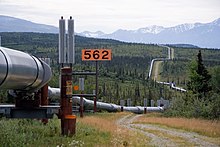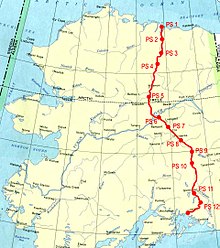| Trans-Alaska Pipeline System | |
|---|---|
 The trans-Alaska oil pipeline, as it zig-zags across the landscape | |
 Location of trans-Alaska pipeline | |
| Location | |
| Country | Alaska, United States |
| Coordinates | 70°15′26″N 148°37′8″W / 70.25722°N 148.61889°W |
| General direction | North–South |
| From | Prudhoe Bay, Alaska |
| Passes through | |
| To | Valdez, Alaska |
| Runs alongside | |
| General information | |
| Type | Pump stations |
| Owner | Alyeska Pipeline Service Company |
| Partners |
|
| Commissioned | 1977[1][2][3] |
| Technical information | |
| Length | 800.3 mi (1,288.0 km) |
| Maximum discharge | 2.136 million bbl/d (339,600 m3/d) |
| Diameter | 48 in (1,219 mm) |
| No. of pumping stations | 12 |
The Trans-Alaska Pipeline System (TAPS) is an oil transportation system spanning Alaska, including the trans-Alaska crude-oil pipeline, 12 pump stations, several hundred miles of feeder pipelines, and the Valdez Marine Terminal. TAPS is one of the world's largest pipeline systems. The core pipeline itself, which is commonly called the Alaska pipeline, trans-Alaska pipeline, or Alyeska pipeline, (or The pipeline as referred to by Alaskan residents), is an 800-mile (1,287 km) long, 48-inch (1.22 m) diameter pipeline that conveys oil from Prudhoe Bay, on Alaska's North Slope, south to Valdez, on the shores of Prince William Sound in southcentral Alaska. The crude oil pipeline is privately owned by the Alyeska Pipeline Service Company.
Oil was first discovered in Prudhoe Bay in 1968 and the 800 miles of 48" steel pipe was ordered from Japan in 1969 (U.S. steel manufacturers did not have the capacity at that time). However, construction was delayed for nearly 5 years due to legal and environmental issues. The eight oil companies that owned the rights to the oil hired Bechtel for the pipeline design and construction and Fluor for the 12 pump stations and the Valdez Terminal. Preconstruction work during 1973 and 1974 was critical and included the building of camps to house workers, construction of roads and bridges where none existed, and carefully laying out the pipeline right of way to avoid difficult river crossings and animal habitats. Construction of the pipeline system took place between 1975 and 1977. It was important for the United States to have a domestic source of oil to offset the high rise in foreign oil and the Alaska Pipeline fulfilled that obligation.
Building oil pipelines in the 1950s and 60s was not difficult in the contiguous United States. However, in building the Alaska Pipeline, engineers faced a wide range of difficulties, stemming mainly from the extreme cold and the difficult, isolated terrain. The construction of the pipeline was one of the first large-scale projects to deal with problems caused by permafrost, and special construction techniques had to be developed to cope with the frozen ground. The project attracted tens of thousands of workers to Alaska due to high wages, long work hours, and paid-for housing, causing a boomtown atmosphere in Valdez, Fairbanks, and Anchorage.
The first barrel of oil traveled through the pipeline in the summer of 1977,[1][2][3][4] with full-scale production by the end of the year. Several notable incidents of oil leakage have occurred since, including those caused by sabotage, maintenance failures, and bullet holes.[5] As of 2015, it had shipped over 17 billion barrels (2.7×109 m3) of oil.[6] The pipeline has been shown capable of delivering over two million barrels of oil per day but nowadays usually operates at a fraction of maximum capacity. If flow were to stop or throughput were too little, the line could freeze. The pipeline could be extended and used to transport oil produced from controversial proposed drilling projects in the nearby Arctic National Wildlife Refuge (ANWR).
- ^ a b "'Pig' leading flow of oil in pipeline". Eugene Register-Guard. (Oregon). UPI. June 20, 1977. p. 1A.
- ^ a b "Hot North Slope oil flowing". Spokane Daily Chronicle. Washington. Associated Press. June 20, 1977. p. 1.
- ^ a b "Valdez celebrates arrival of first oil". Eugene Register-Guard. (Oregon). Associated Press. July 29, 1977. p. 1A.
- ^ "Tanker casts off with load of oil". Eugene Register-Guard. (Oregon). wire services. August 2, 1977. p. 3A.
- ^ Verhovek, Sam Howe (October 6, 2001). "Pipeline Crews Tackle Huge Oil Spill Caused by Shooting". The New York Times. ISSN 0362-4331. Retrieved June 7, 2023.
- ^ 2016 Fact Book, p. 71